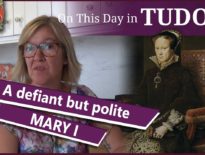On this day in Tudor history, 20th August 1589, twenty-three-year-old King James VI of Scotland married fourteen-year-old Anne of Denmark by proxy at Kronborg Castle, Helsingør, Denmark.
James had chosen Anne of Denmark as his bride after praying and meditating over portraits of her and Catherine of Navarre, and Anne was very excited about marrying him. Unfortunately, married bliss didn't last long.
Find out more about the proxy wedding, Anne's eventful voyage, their real wedding and their married life, in today's talk.
Also on this day in Tudor history, 20th August 1588, there was a thanksgiving service at St Paul's to thank God for his divine intervention when England defeated the Spanish Armada. It was thought that God had sent his Protestant Wind to save England from Catholic Spain. Find out more in last year’s video:
Also on this day in history:
- 1509 – Birth of Sir William Stanford (Staunford), judge and legal writer. Stanford served Mary I as one of her queen's Sergeants, and is known for his legal books, “Les plees del coron” (1557), on criminal law, and “Exposicion of the Kinges Prerogative” (1567)
- 1580 – Death of Sir George Bowes, soldier and administrator, at Streatlam, county Durham. He was buried in the family vault at Barnard Castle Church. Bowes served Elizabeth I as a member of the Council of the North and the Ecclesiastical High Commission for York, a Justice of the Peace and Sheriff, and as the Earl of Sussex's Deputy in co. Durham and Richmondshire, and Provost Marshal. Bowes was also chosen to escort Mary, Queen of Scots from Carlisle to Bolton Castle in 1568.
- 1599 (some sources say 20th) – Death of Sir Thomas Norris, soldier and Lord President of Munster, at his house at Mallow, County Cork, Ireland. Norris died from an injury to his jaw sustained in a skirmish with Thomas Burke and his troops in May 1599.
- 1610 – Death of courtier Edmund Tilney, censor of plays and Master of the Revels. He was buried in St. Leonard's Church, Streatham, London.
- 1648 (or 5th August) – Death of Edward Herbert, 1st Baron Herbert of Cherbury and 1st Baron Herbert of Castle Island, diplomat, philosopher and the author of “The Life and Raigne of King Henry the Eighth”. He was buried at St Giles-in-the-Fields, London.
Transcript:
On this day in Tudor history, 20th August 1589, twenty-three-year-old King James VI of Scotland married fourteen-year-old Anne of Denmark by proxy at Kronborg Castle, Helsingør, Denmark. James was represented by his ambassador at the Danish court, George Keith, 5th Earl Marischal.
James was the son of Mary, Queen of Scots, and her second husband, Henry Stuart, Lord Darnley, and he’d been King of Scotland when he was just one year old after his mother had been forced to abdicate in June 1567 following her marriage to James Hepburn, Earl of Bothwell, a man who had been implicated in the murder of Lord Darnley a few months earlier.
Anne of Denmark was the second daughter of the late King Frederick II of Denmark, and his wife, Queen Sophia, and sister King Christian IV of Denmark.
James had chosen Anne as his bride after praying and meditating for three days over portraits of Anne and another prospective bride, thirty-year-old Catherine of Navarre. Anne was keen on marrying James and it was recorded that she was “so far in love with the King's Majesty as it were death to her to have it broken off and hath made good proof divers ways of her affection which his Majestie is apt enough to requite”, and she set about embroidering shirts for him.
In June 1589 a Scottish embassy a Scottish embassy travelled to Denmark to finalise the marriage negotiations, which saw Denmark giving up on the idea of Scotland returning the isles of Orkney and Shetland, and agreeing to a dowry of 75,000 rixdollars, or £150,000 Scots pounds. On this day in Tudor history, 20th August 1589, the proxy wedding took place in Kronborg Castle’s great hall. Anne’s fleet of ships set sail for Scotland on 5th September, but it wasn’t plain sailing. A cannon saluting Anne on her departure blew up, killing two gunners, and then a cannon on Anne’s ship exploded, killing another gunner. Then, there were awful storms on the voyage, which delayed the voyage as they had to seek refuge in the Norwegian fjords and Anne then travelled by land to Oslo. James, impatient at waiting for his new bride, set off for Norway, arriving on 19th November. On 23rd November 1589, James and Anne married in person at the Old Bishop’s Palace in Oslo, with James’s chaplain, David Lindsay, conducting the ceremony in French, which Anna had learned so that she and James had a common language.
Although the marriage started well, it didn’t stay happy. Both of them were the subject of scandalous romantic rumours, and there were also disagreements over the bringing up of their children, religion, Anne’s household, James’s drinking, and their different lifestyles.
Anne had a number of pregnancies that ended in miscarriage and out of the seven children who were survived birth, three of them died young. Their eldest son, Henry, died aged 18, and James was succeeded by their second son, Charles as Charles I.
As I said, today is the anniversary of their proxy wedding. But what was a proxy wedding?
Well, a proxy wedding was a ceremony where either the bride or groom, or even both, were represented by a proxy, i.e. someone who stood in for the person. The wedding was a normal wedding and the proxy made vows on behalf of the person they represented. It was legal and binding, rather than just being a practice ceremony or some kind of dress rehearsal for the big day. In this case, James was represented by a proxy, George Keith, who made vows on his behalf, but Anne was there in person.
Proxy marriages weren’t commonplace for normal citizens, as there was no need, but they were quite common from the Middle Ages onwards for diplomatic unions between the ruling houses of Europe. Peace treaties between countries or empires often comprised a marriage agreement but travelling time or situations could make it difficult for the couple to get together quickly to solidify the agreement. Rulers didn’t want to risk an advantageous match or peace by having to postpone the actual wedding for a few months.



While in Denmark James met a number of people interested in the natural sciences and witchcraft and he learned much that he later here as well. He thought the storms which upset his wife’s ship on the way back was caused by witchcraft. This lead to the trials of the Berwick Witches and particularly one Agnes Sampson, a local well respected healer. She was dragged before James and she was questioned and then probably tortured and admitted her alleged crimes and she said she was a leader of a group of witches. Other women were questioned and they accused others and so on until over 200 people were accused of one huge conspiracy against James and his wife. A good number were executed. James would go on to write his Demonologie as a way to identify real witches, not just to hunt witches. It was often misused as these things often were and James became more sceptical in his later years. A brilliant mind, but clearly unable to realise storms are random forces of nature, not means of assassination of Kings.
Anne also became a Roman Catholic which couldn’t have helped their marriage, although his going over to bring her safe to Scotland is a rather romantic gesture.